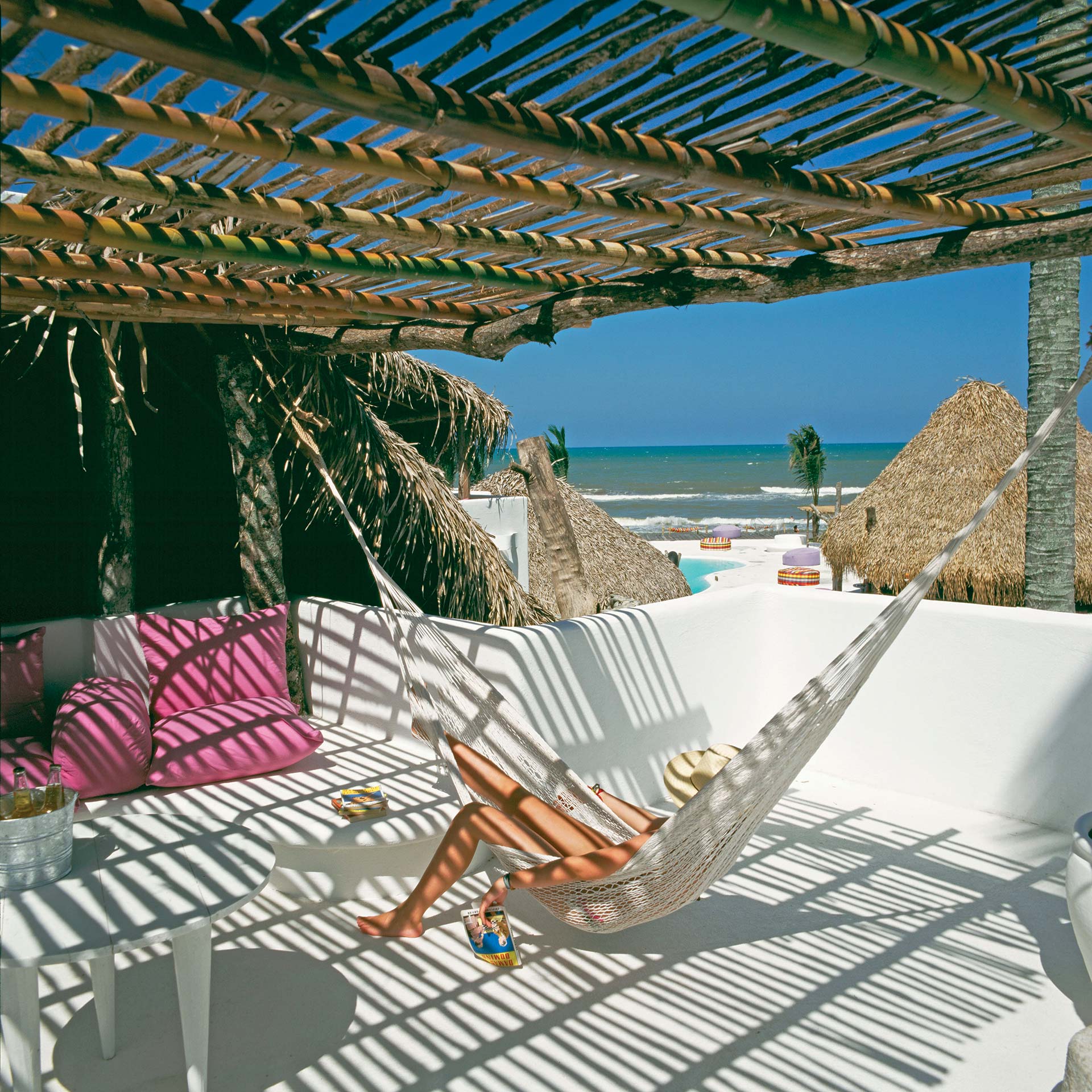
Grupo Habita launched 25 years ago in Mexico, among the first to perfect the formula for what would become the modern boutique hotel — wildly popular now, but a novel concept at the time.
By Mark Fedeli
Marketing and Editorial Director, Tablet Hotels
It’s wild when you think back now, but there was a time, not all that long ago, when boutique hotels were few and far between. Tablet launched right in the thick of this era, in the year 2000, when it was easy to identify a boutique hotel — so different they were from the all the identical chains and aging luxury palaces — but hard to find too many of them in any given place.
Now, everything can feel like a boutique hotel. The boutique sub-brands of the big chains have their own boutique sub-brands. They all have a story of some sort, a stated inspiration beyond just providing clean and convenient shelter. Maybe they even have a piece of local history lying in the lobby. What they’re all chasing is the winning formula that Grupo Habita helped define.
The Grupo Habita story also starts in 2000 with the opening of Hotel Habita in Mexico City. There, they did what they would continue to do at more than a dozen other properties spread across Mexico (and even one in the United States): find cutting-edge architects and designers and give them a canvas upon which to express the soul of the location and its surrounding culture. Often these creatives were young and up-and-coming and eager to manifest thought-provoking spaces that would demand attention, and attract locals as much as tourists.

It all sounds so obvious in hindsight, but this type of hotel development was outside the norm in 2000. It was seen as a risk to be so specific and so full of personality in such competitive markets — to alienate large swaths of potential guests who might prefer something more safe and middle-of-the-road. But what the Grupo Habita founders realized — what Tablet Hotels realized, too — was that there were more than enough people who wanted something more interesting, something more considered, something specifically more specific.
What they brought forth wasn’t just a refuge for outsiders. They, along with a small handful of other pioneering boutique hotel groups, established a new hospitality language that shifted the conversation and realigned the mainstream. That’s a lesson every business could learn from: double down on what makes you different. Don’t guess at what you think will make the most people happy. Show them instead what matters most to you. Make them crave what they never knew they wanted.
If you build it, they will come.
Hotel Habita
Mexico City, Mexico
Hotel Habita is the very face of urban boutique cool, wrapped in an outer layer of frosted glass, extending an old apartment block’s volume out into space, making corridors of the old balconies, keeping the cool air in and the street noise out. In daylight it resembles a block of ice, and at night an outsize paper lantern — a radical departure from the stately residential buildings of the upscale Polanco neighborhood.
Condesa df
Mexico City, Mexico
Condesa DF is a perfect fit for a neighborhood stuffed with cafes, boutiques and galleries. This conversion of a 1928 apartment block is nothing if not stylish, highly modern without coming off cold or over-designed. The interiors are by the Parisian designer India Mahdavi, whose custom-designed details — from the furniture in the rooms to the tableware in the restaurant — convey a strong sense of personality.
Downtown Mexico
Mexico City, Mexico
Downtown Mexico occupies a brick-fronted 17th-century palace a short walk from the Plaza de la Constitución, as central a location as a Mexico City hotel could ask for. Inside, the signature Habita architectural flair: the original high ceilings remain intact, among other charmingly weathered period details, but the prevailing atmosphere is that of a very clean, very contemporary modern boutique style.
Círculo Mexicano
Mexico City, Mexico
A 19th-century building in the Centro Histórico has been updated by architects Ambrosi Etchegaray into Círculo Mexicano, a striking and unique 25-room boutique hotel. The rooms are designed in a Shaker-inspired minimalist style, in simple traditional materials and Oaxacan textiles, with clutter kept to a minimum and subtle luxuries where they count, including furniture by local design studio La Metropolitana.
La Purificadora
Puebla, Mexico
This 19th-century water processing plant (hence the name) and bottling factory was redesigned by the famous Mexican modernist architect Ricardo Legorreta, the man behind Mexico City’s famous Camino Real hotel. It’s a departure from his brightly colored mid-century masterpiece — aside from some judiciously applied violets, La Purificadora is fairly austere, with the exterior walls and some interior surfaces remaining untouched and unpainted.
Hotel Habita Monterrey
Monterrey, Mexico
While other hotels in Monterrey play to the town’s colonial heritage, the Habita opts for contemporary lines and a striking and utterly modern black-and-white color scheme, courtesy of the Mexican architect Agustín Landa and the Parisian interior designer Joseph Dirand. With thirty-nine rooms it keeps to the intimate scale that the Habita group does best. The rooms stake out that middle ground between design-hotel chic and high-end luxe.
Casa Habita
Guadalajara, Mexico
Located in Guadalajara’s lively Zona Minerva, Casa Habita is a chic 37-room hotel with a minimalist aesthetic and a breezy rooftop terrace. The design has a distinctly European feel, though most of the materials, from stone to textiles, were sourced in Jalisco. Guest rooms are spare and geometric, fitted with glass panes, metallic surfaces, and luxurious marble bathrooms. Upstairs, a rooftop swimming pool provides a calm respite.
Hotel Azucar
Veracruz, Mexico
The little beach town of Veracruz is the perfect place for a design-savvy eco-retreat like Hotel Azucar — instead of post-industrial concrete and oil tanks, here we’re back to thatched-roof bungalows, albeit ones with crisp all-white contemporary bedrooms inside. The construction is sustainable and environmentally friendly, a reaction against the despoilment that followed in the wake of Mexico’s first mega-resorts.
Maison Couturier
San Rafael, Mexico
Mexico’s a big place, with more geographic and cultural diversity than the travel industry might have you believe. The stereotypical picture of sun and surf is accurate, to a point, but doesn’t include this little French enclave in the Caribbean coastal state of Veracruz, home to a nineteenth-century estate, fringed with lush vegetation, surrounded by banana plantations, and today operating as a nine-room boutique hotel called Maison Couturier.
Baja Club
La Paz, Mexico
La Paz, the capital city of Baja California Sur, is the setting for Baja Club, a 1910-vintage colonial-style villa that’s been renovated and expanded by architects Max von Werz Arquitectos and Jaune Architecture into a one-of-a-kind marriage of classic luxury and contemporary design. Inside its hacienda-style courtyard, weathered brick walls contrast with a modern structure lined with the guest rooms’ balconies and patios.
Hotel Escondido Oaxaca
Oaxaca City, Mexico
The historical center of the city of Oaxaca is a wonder — a UNESCO World Heritage Site and a fantastic tapestry of every era from the 16th century to the present. Hotel Escondido Oaxaca is a blend of its own, a 19th-century house and an attached neo-Brutalist structure, combining to create a contemporary boutique hotel designed with an eye towards blurring the distinctions between old and new.
Otro Oaxaca
Oaxaca City, Mexico
For Otro Oaxaca, local architect João Boto Caeiro has masterfully mixed traditional Oaxacan textures and materials — and overt references to Zapotec archaeological sites — with modernist geometries and minimalist interiors. The result is both unmistakably Oaxacan and quite unlike anything else in Oaxaca City. There’s a rooftop plunge pool and a subterranean spa whose 20-foot circular pool feels like a man-made cenote.
Hotel Escondido
Puerto Escondido, Mexico
Hotel Escondido is essentially “barefoot luxe” at its apex, a sort of impossibly stylish version of beach-bum living, its sixteen bungalows smallish and spare but perfectly formed. The restaurant serves can’t-miss local seafood, the bar shows off the Habita talent for hospitality, and the pool lounge mixes modern design with the most primitive of elements, to the greatest possible effect.
Hotel Terrestre
Puerto Escondido, Mexico
Puerto Escondido is a well-established destination — but it’s never seen anything like Hotel Terrestre. Then again, neither has anywhere else. Set between the mountains and the sea on the verdant coast just to the west of town, it’s a dramatic structure, a spaceship made of humble, locally sourced brick and concrete by architect Alberto Kalach. It’s as sustainable as can be, not just in construction but in operation as well.
Hotel Humano
Puerto Escondido, Mexico
Tucked along a pedestrian lane in La Punta Zicatela, and just steps from Puerto Escondido’s iconic surf, Hotel Humano’s minimalist forms and earthy palette — concrete, tropical wood, handmade tiles — frame 39 thoughtfully composed rooms. The rooftop spa, courtyard pool, and chef-driven restaurant echo the laid-back rhythm of the coast. Local materials and bespoke furnishings reflect the soul of the Pacific, grounded in place and purpose.
The Robey
Chicago, IL, USA
When one of your favorite hotel brands moves into one of your favorite underutilized buildings, it’s a win-win. Habita’s Robey is the new occupant of North Tower, a 1929 Art Deco skyscraper in Chicago’s Wicker Park. The Mexican mini-chain tapped a Belgian design team, Nicolas Schuybroek Architects and Marc Merckx Interiors, to overhaul the place, reshaping office space into 89 guest rooms and a handful of cafés and lounges, including a striking indoor-outdoor bar on the 13th floor.

Mark Fedeli is the hotel marketing and editorial director for Tablet and Michelin Guide. He’s been with Tablet since 2006, and he thinks you should subscribe to our newsletter.


















